STS-84 Biographies
| Precourt | Collins | Noriega | Lu | Clervoy | Kondakova | Foale | Linenger |

NAME: Charles J. Precourt (Colonel, USAF, Ret.) NASA Astronaut
PERSONAL DATA: Born June 29, 1955, in Waltham, Massachusetts, but considers Hudson, Massachusetts, to be his hometown. Married to the former Lynne Denise Mungle of St. Charles, Missouri. They have three daughters, Michelle, Sarah, and Aimee. Precourt enjoys golf and flying light aircraft. He flies a Varieze, an experimental aircraft that he built. His parents, Charles and Helen Precourt, reside in Hudson. Her parents, Loyd and Jerry Mungle, reside in Streetman, Texas.
EDUCATION: Graduated from Hudson High School, Hudson, Massachusetts, in 1973; received a bachelor of science degree in aeronautical engineering from the United States Air Force Academy in 1977, a master of science degree in engineering management from Golden Gate University in 1988, and a master of arts degree in national security affairs and strategic studies from the United States Naval War College in 1990. While at the United States Air Force Academy, Precourt also attended the French Air Force Academy in 1976 as part of an exchange program. Fluent in French and Russian.
ORGANIZATIONS: Vice President of the Association of Space Explorers; member of the Society of Experimental Test Pilots (SETP), and the Experimental Aircraft Association.
SPECIAL HONORS: Military decorations include: the Defense Superior Service Medal (2); the Distinguished Flying Cross; the Air Force Meritorious Service Medal (2). Distinguished graduate of the United States Air Force Academy and the United States Naval War College. In 1978 he was the Air Training Command Trophy Winner as the outstanding graduate of his pilot training class. In 1989 he was recipient of the David B. Barnes Award as the Outstanding Instructor Pilot at the United States Air ForceTest Pilot School. NASA awards include: the NASA Distinguished Service Medal; the Exceptional Service Medal and Outstanding Leadership Medal; and the NASA Space Flight Medal (4).
EXPERIENCE: Precourt graduated from Undergraduate Pilot Training at Reese Air Force Base, Texas, in 1978. Initially he flew as an instructor pilot in the T-37, and later as a maintenance test pilot in the T-37 and T-38 aircraft. From 1982 through 1984, he flew an operational tour in the F-15 Eagle at Bitburg Air Base in Germany.
In 1985 he attended the United States Air Force Test Pilot School at Edwards Air Force Base in California. Upon graduation, Precourt was assigned as a test pilot at Edwards, where he flew the F-15E, F-4, A-7, and A-37 aircraft until mid 1989, when he began studies at the United States Naval War College in Newport, Rhode Island.
Upon graduation from the War College, Precourt joined the astronaut program. His flight experience includes over 7,000 hours in over 60 types of civil and military aircraft. He holds commercial pilot, multi-engine instrument, glider and certified flight instructor ratings. Precourt retired from the Air Force on March 31, 2000.
NASA EXPERIENCE: Precourt is currently the Chief of the Astronaut Corps, responsible for the mission preparation activities of all Space Shuttle and future International Space Station crews and their support personnel.
Selected by NASA in January 1990, Precourt became an astronaut in July 1991. His other technical assignments to date have included: Manager of ascent, entry, and launch abort issues for the Astronaut Office Operations Development Branch; spacecraft communicator (CAPCOM), providing the voice link from the Mission Control Center during launch and entry for several Space Shuttle missions; Director of Operations for NASA at the Gagarin Cosmonaut Training Center in Star City, Russia, from October 1995 to April 1996, with responsibility for the coordination and implementation of mission operations activities in the Moscow region for the joint U.S./Russian Shuttle/Mir program. He also served as Acting Assistant Director (Technical), Johnson Space Center.
A veteran of four space flights, he has logged over 932 hours in space. He served as a mission specialist on STS-55 (April 26 to May 6, 1993), was the pilot on STS-71 (June 27 to July 7, 1995), and was the spacecraft commander on STS-84 (May 15-24, 1997) and STS-91 (June 2-12, 1998), the final scheduled Shuttle-Mir docking mission, concluding the joint U.S./Russian Phase I Program.
_______________________________________________________________
| Precourt | Collins | Noriega | Lu | Clervoy | Kondakova | Foale | Linenger |
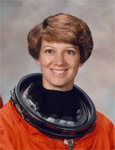
NAME: Eileen Marie Collins (Colonel, USAF) NASA Astronaut
PERSONAL DATA: Born November 19, 1956, in Elmira, New York. Married to Pat Youngs, originally from San Antonio, Texas. They have one child. She enjoys running, golf, hiking, camping, reading, photography, astronomy. Her parents are James and Rose Marie Collins, from Elmira, New York. His parents are Pat and Jackie Youngs, from San Antonio, Texas.
EDUCATION: Graduated from Elmira Free Academy, Elmira, New York, in 1974; received an associate in science degree in mathematics/science from Corning Community College in 1976; a bachelor of arts degree in mathematics and economics from Syracuse University in 1978; a master of science degree in operations research from Stanford University in 1986; and a master of arts degree in space systems management from Webster University in 1989.
ORGANIZATIONS: Member of the Air Force Association, Order of Daedalians, Women Military Aviators, U.S. Space Foundation, the American Institute of Aeronautics and Astronautics, and the Ninety-Nines.
SPECIAL HONORS: Awarded the Defense Superior Service Medal, the Air Force Meritorious Service Medal with one oak leaf cluster, the Air Force Commendation Medal with one oak leaf cluster, the Armed Forces Expeditionary Medal for service in Grenada (Operation Urgent Fury, October 1983), and the NASA Space Flight Medal.
EXPERIENCE: Collins graduated in 1979 from Air Force Undergraduate Pilot Training at Vance AFB, Oklahoma, where she was a T-38 instructor pilot until 1982. From 1983 to 1985, she was a C-141 aircraft commander and instructor pilot at Travis AFB, California. She spent the following year as a student with the Air Force Institute of Technology. From 1986 to 1989, she was assigned to the U.S. Air Force Academy in Colorado, where she was an assistant professor in mathematics and a T-41 instructor pilot. She was selected for the astronaut program while attending the Air Force Test Pilot School at Edwards AFB, California, from which she graduated in 1990.
She has logged over 5,000 hours in 30 different types of aircraft.
NASA EXPERIENCE: Selected by NASA in January 1990, Collins became an astronaut in July 1991. Initially assigned to Orbiter engineering support, she has also served on the astronaut support team responsible for Orbiter prelaunch checkout, final launch configuration, crew ingress/egress, landing/recovery, worked in Mission Control as a spacecraft communicator (CAPCOM) for numerous Shuttle missions, and served as the Astronaut Office Spacecraft Systems Branch Chief. A veteran of three space flights, Collins has logged over 537 hours in space. She served as pilot on STS-63 (February 2-11, 1995) and STS-84 (May 15-24, 1997), and was the first woman Shuttle commander on STS-93 (July 22-27, 1999).
STS-63 (February 2-11, 1995) was the first flight of the new joint Russian-American Space Program. Mission highlights included the rendezvous with the Russian Space Station Mir, operation of Spacehab, the deployment and retrieval of an astronomy satellite, and a space walk. Collins' first mission was accomplished in 129 orbits, traveling over 2.9 million miles in 198 hours, 29 minutes. She was the first woman pilot of a Space Shuttle.
STS-84 (May 15-24, 1997) was NASA's sixth Shuttle mission to rendezvous and dock with the Russian Space Station Mir. During the flight, the crew conducted a number of secondary experiments and transferred nearly 4 tons of supplies and experiment equipment between Atlantis and the Mir station. In completing this 9-day mission, she traveled 3.8 million miles in 145 orbits of the Earth logging a total of 221 hours and 20 minutes in space.
STS-93 Columbia (July 22-27, 1999) was the first Shuttle mission to be commanded by a woman. STS-93 highlighted the deployment of the Chandra X-Ray Observatory. Designed to conduct comprehensive studies of the universe, the telescope will enable scientists to study exotic phenomena such as exploding stars, quasars, and black holes. Mission duration was 118 hours and 50 minutes.
_______________________________________________________________
| Precourt | Collins | Noriega | Lu | Clervoy | Kondakova | Foale | Linenger |
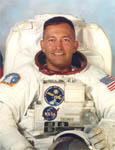
NAME: Carlos I. Noriega (Lieutenant Colonel, USMC) NASA Astronaut
PERSONAL DATA: Born October 8, 1959, in Lima, Peru. Considers Santa Clara, California, to be his hometown. Married to the former Wendy L. Thatcher. They have five children. He enjoys flying, running, snow skiing, racquetball, and spending time with his children. His parents, Rodolfo and Nora Noriega, reside in Gilbert, Arizona. Her parents, John and Elizabeth Thatcher, reside in Honolulu, Hawaii.
EDUCATION: Graduated from Wilcox High School, Santa Clara, California, in 1977. Bachelor of science degree in computer science from University of Southern California, 1981. Master of science degree in computer science from the Naval Postgraduate School, 1990. Master of science degree in space systems operations from the Naval Postgraduate School, 1990.
SPECIAL HONORS: Defense Superior Service Medal, Defense Meritorious Service Medal, Air Medal with Combat Distinguishing Device, Air Medal (Strike Flight Award), Navy Achievement Medal, NASA Space Flight Medal.
EXPERIENCE: Noriega was a member of the Navy ROTC unit and received his commission in the United States Marine Corps at the University of Southern California in 1981. Following graduation from flight school, he flew CH-46 Sea Knight helicopters with HMM-165 from 1983 to 1985 at Marine Corps Air Station (MCAS) Kaneohe Bay, Hawaii.
Noriega made two 6-month shipboard deployments in the West Pacific/Indian Ocean including operations in support of the Multi-National Peacekeeping Force in Beirut, Lebanon. He completed his tour in Hawaii as the Base Operations Officer for Marine Air Base Squadron 24. In 1986, he was transferred to MCAS Tustin, California, where he served as the aviation safety officer and instructor pilot with HMT-301.
In 1988, Noriega was selected to attend the Naval Postgraduate School in Monterey, California, where he earned two master of science degrees. Upon graduation in September 1990, he was assigned to United States Space Command in Colorado Springs, Colorado. In addition to serving as a Space Surveillance Center Commander, he was responsible for several software development projects and was ultimately the command representative for the development and integration of the major space and missile warning computer system upgrades for Cheyenne Mountain Air Force Base. At the time of his selection, he was serving on the staff of the 1st Marine Aircraft Wing in Okinawa, Japan.
He has logged approximately 2,200 flight hours in various fixed wing and rotary wing aircraft.
NASA EXPERIENCE: Selected by NASA in December 1994, Noriega reported to the Johnson Space Center in March 1995. He completed a year of training and evaluation, and was qualified for assignment as a mission specialist in May 1996. He has had technical assignments in the Astronaut Office EVA/Robotics and Operations Planning Branches. He flew on STS-84 in 1997 and has logged over 221 hours in space.
Lt. Col. Noriega will serve on the crew of STS-97, the fifth Space Shuttle mission dedicated to the assembly of the International Space Station. STS-97 will bring the P6 Integrated Truss segment which provides electrical power and heat dissipation to the station. He is scheduled to conduct 2 space walks on this mission. Launch is targeted for late 2000.
STS-84 (May 15-24, 1997), was NASA's sixth Shuttle mission to rendezvous and dock with the Russian Space Station Mir. During this 9-day mission the crew aboard Space Shuttle Atlantis conducted a number of secondary experiments, and transferred nearly 4 tons of supplies and experiment equipment between Atlantis and the Mir station. During STS-84 Noriega logged a total of 221 hours and 20 minutes in space traveling 3.6 million miles in 144 orbits of the Earth.
_______________________________________________________________
| Precourt | Collins | Noriega | Lu | Clervoy | Kondakova | Foale | Linenger |
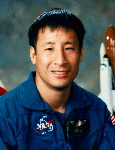
NAME: Edward Tsang Lu (Ph.D.) NASA Astronaut
PERSONAL DATA: Born July 1, 1963, in Springfield, Massachusetts. Considers Honolulu, Hawaii, and Webster, New York, to be his hometowns. Unmarried. He enjoys aerobatic flying, coaching wrestling, piano, tennis, surfing, skiing, travel. His parents, Charlie and Snowlily Lu, reside in Fremont, California.
EDUCATION: Graduated from R.L. Thomas High School, Webster, New York, in 1980. Bachelor of science degree in electrical engineering from Cornell University, 1984. Doctorate in applied physics from Stanford University, 1989.
ORGANIZATIONS: American Astronomical Society, Aircraft Owners and Pilots Association, Experimental Aircraft Association.
SPECIAL HONORS: Cornell University Presidential Scholar, Hughes Aircraft Company Masters Fellow.
EXPERIENCE: Since obtaining his Ph.D., Dr. Lu has been a research physicist working in the fields of solar physics and astrophysics. He was a visiting scientist at the High Altitude Observatory in Boulder, Colorado, from 1989 until 1992, the final year holding a joint appointment with the Joint Institute for Laboratory Astrophysics at the University of Colorado.
From 1992 until 1995, he was a postdoctoral fellow at the Institute for Astronomy in Honolulu, Hawaii. Dr. Lu has developed a number of new theoretical advances which have provided for the first time a basic understanding of the underlying physics of solar flares. He has published articles on a wide range of topics including solar flares, cosmology, solar oscillations, statistical mechanics, and plasma physics.
He holds a commercial pilot certificate with instrument and multi-engine ratings, and has over 1000 hours of flying time.
NASA EXPERIENCE: Selected by NASA in December 1994, Dr. Lu reported to the Johnson Space Center in March 1995, has completed a year of training and evaluation, and is qualified for assignment as a mission specialist. Among technical assignments held since then Dr. Lu has worked in the astronaut office computer support branch, and has served as lead astronaut for Space Station training issues.
Dr. Lu flew as a mission specialist on STS-84 in 1997, and was a mission specialist and payload commander on STS-106 in 2000. Twice flown, Dr. Lu has logged over 504 hours in space, and an EVA (spacewalk) totalling 6 hours and 14 minutes.
STS-84 Atlantis (May 15-24, 1997), was NASAÆs sixth Shuttle mission to rendezvous and dock with the Russian Space Station Mir. In completing this 9-day mission, Dr. Lu traveled 3.6 million miles in 144 orbits of the Earth logging a total of 221 hours and 20 minutes in space.
STS-106 Atlantis (September 8-20, 2000). During the 12-day mission, the crew successfully prepared the International Space Station for the arrival of the first permanent crew. The five astronauts and two cosmonauts delivered more than 6,600 pounds of supplies and installed batteries, power converters, life support, and exercise equipment on the Space Station. Ed Lu and Yuri Malenchenko performed a 6 hour and 14 minute space walk in order to connect power, data and communications cables to the newly arrived Zvezda Service Module and the Space Station. STS-106 orbited the Earth 185 times, and covered 4.9 million miles in 11 days, 19 hours, and 10 minutes.
_______________________________________________________________
| Precourt | Collins | Noriega | Lu | Clervoy | Kondakova | Foale | Linenger |
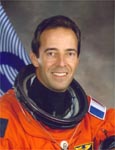
NAME: Jean-Franτois Clervoy ESA Astronaut
PERSONAL DATA: Born November 19, 1958, in Longeville-les-Metz, France, but considers Toulouse, France, to be his hometown. Married to the former Laurence Boulanger. They have two children. He enjoys racquet sports, skill games, canyoning, skiing, and flying activities such as boomerang, frisbee, kites. His father, Jean Clervoy (French Air Force, Ret.), and his mother, Mireille Clervoy, reside in Franconville, France. Her parents, Robert and Juliette Boulanger, reside in Le Perreux-sur-Marne, France.
EDUCATION: Received his baccalaurΘat from CollΦge Militaire de Saint Cyr l' Ecole in 1976; passed Math. Sup. and Math. SpΘ. M' at PrytanΘe Militaire, La FlΦche in 1978. Graduated from Ecole Polytechnique, Paris, in 1981; graduated from Ecole Nationale SupΘrieure de l' AΘronautique et de l' Espace, Toulouse, in 1983; graduated as a Flight Test Engineer from Ecole du Personnel Navigant d' Essais et de RΘception, Istres, in 1987.
ORGANIZATIONS: Member, Association of Space Explorers. Honorary member of the French Aeronautics and Astronautics Association.
SPECIAL HONORS: NASA Space Flight Medal. Chevalier de l' Ordre National du MΘrite. Chevalier de l' Ordre National de la LΘgion d' Honneur. Komarov Award. NASA Exceptional Service Medal.
EXPERIENCE: Clervoy was seconded from the DΘlΘgation GΘnΘrale pour L' Armement (DGA) to CNES (French Space Agency) in 1983, where he worked on automatics and attitude control systems for several satellite projects. He was selected in the second group of French astronauts in 1985 and subsequently undertook intensive Russian language training.
After graduating as a flight test engineer in 1987, he spent the next five years part-time at the Flight Test Center, BrΘtigny-sur-Orge, as Chief Test Director of the Parabolic Flight Program, responsible for testing and qualifying the Caravelle aircraft for microgravity, and part-time at the Hermes Crew Office, Toulouse, where he supported the European Manned Space Programs in the fields of extravehicular activity, rendezvous and docking, robotic arm, and man machine interface.
In 1991, he trained in Star City, Moscow, on the Soyuz and Mir systems. In 1992, he was selected to join the astronaut corps of the European Space Agency (ESA). He holds military and civilian parachuting licenses, military and civilian diving licenses, and private pilot license. From 1983 to 1987, Clervoy was also a lecturer in signal processing and general mechanics at the Ecole Nationale SupΘrieure de l' AΘronautique et de l' Espace, Toulouse.
Jean-Franτois holds a commission as IngΘnieur en Chef de l' Armement in the DGA.
NASA EXPERIENCE: Clervoy reported to the Johnson Space Center in August 1992. Following one year of training he qualified as a mission specialist for Space Shuttle flights. Clervoy was initially assigned to the Astronaut Office Mission Development Branch where he designed a new concept of robotic steering displays.
After his first space mission he was assigned as flight software verification lead in the Shuttle Avionics Integration Laboratory (SAIL) and was responsible for designing the International Space Station (ISS) robotics displays for the Astronaut Office Mission Support Branch.
Following his second space mission, he served as ISS displays integration lead for the Astronaut Office Computer Support Branch. A veteran of three space flights, Clervoy has logged over 674 hours in space. He served as a mission specialist on STS-66 in 1994, was the Payload Commander on STS-84 in 1997, and again served as a mission specialist on STS-103 in 1999. Clervoy currently leads the crew interface and software section for the Astronaut Office Space Station Branch.
STS-66 Atlantis (November 3-14, 1994), the Atmospheric Laboratory for Applications and Science-3 (ATLAS-3) mission was part of an ongoing program to determine the Earth's energy balance and atmospheric change over an eleven-year solar cycle. Clervoy used the robotic arm to deploy the CRISTA-SPAS atmospheric research satellite 20 hours after lift-off, and logged 262 hours and 34 minutes in space and 175 orbits of the Earth.
STS-84 Atlantis (May 15-24, 1997), was NASA's sixth Shuttle mission to rendezvous and dock with the Russian Space Station Mir. Clervoy's primary tasks were the coordination of the execution of more than 20 experiments, the operation of the docking system and the double module SPACEHAB, and the transfer of 4 tons of equipment between Atlantis and Mir. He was also trained as a contingency spacewalker on this mission. STS-84 was accomplished in 144 Earth orbits, traveling 3.6 million miles in 221 hours and 20 minutes.
STS-103 Discovery (December 19-27, 1999) was an 8-day mission during which the crew successfully installed new instruments and upgraded systems on the Hubble Space Telescope (HST). Clervoy was the flight engineer for ascent and entry. He used the robot arm to capture and deploy the telescope, and to maneuver the suited astronauts during 3 eight hour long spacewalks required to repair and upgrade the telescope. The STS-103 mission was accomplished in 120 Earth orbits, traveling 3.2 million miles in 191 hours and 11 minutes.
_______________________________________________________________
| Precourt | Collins | Noriega | Lu | Clervoy | Kondakova | Foale | Linenger |
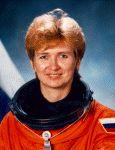
NAME: Elena V. Kondakova, Russian Cosmonaut
PERSONAL DATA: Born March 30, 1957, in Mitischi, Moscow Region. Married to Valerii V. Ryumin, born 1939 in Komsomolskna-Amure, Kharbarovsk Region, Russia. They have one child. Kondakova enjoys the theater, river fishing, reading, traveling. Her father, Vladimir A. Kondakov and her mother, Klavdiya S. Kondakova (Morozova), reside in Kaliningrad, Moscow Region. His parents, Viktor N. Ryumin and Alexandra F. Ryumina (Podporina), are deceased.
EDUCATION: Graduated from Moscow Bauman High Technical College in 1980.
SPECIAL HONORS: Hero of Russia.
EXPERIENCE: Upon graduation, in 1980, Kondakova started to work in RSC-Energia completing science projects, experiments and research work. Then in 1989 she was selected as a cosmonaut candidate by RSC-Energia Main Design Bureau and sent to Gagarin Cosmonaut Training Center to start the course of general space training.
After finishing the course in March, 1990, Kondakova was qualified as "test cosmonaut". From January through June of 1994, she was under training for the 17th main mission and "Euromir-94" flight as a flight engineer of the prime crew.
October 4, 1994 through March 22, 1995, she fulfilled her first flight onboard the spacecraft "Soyuz TM-17" and the orbital complex "Mir" as a flight engineer of the 17th main mission. She spent 169 days in space, including 5 days with NASA Astronaut Norman Thagard. The program included a month long joint flight with German Astronaut Ulf Merbold.
Most recently, she was a mission specialist on STS-84 (May 15-24, 1997), NASA's sixth Shuttle mission to rendezvous and dock with the Russian Space Station Mir. Mission duration was 9 days, 5 hours and 20 minutes. In completing her second flight, Kondakova has logged over 178 days in space.
_______________________________________________________________
| Precourt | Collins | Noriega | Lu | Clervoy | Kondakova | Foale | Linenger |
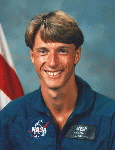
NAME: : C. Michael Foale (Ph.D.) NASA Astronaut
PERSONAL DATA: Born January 6, 1957, in Louth, England, but considers Cambridge, England, to be his hometown. Married to the former Rhonda R. Butler of Louisville, Kentucky. They have two children. He enjoys many outdoor activities, particularly wind surfing. Private flying, soaring, and project scuba diving have been his other major sporting interests. He also enjoys exploring theoretical physics and writing children's software on a personal computer. His parents, Colin and Mary Foale, reside in Cambridge, England. Her parents, Reed & Dorothy Butler, reside in Louisville, Kentucky.
EDUCATION: Graduated from Kings School, Canterbury, in 1975. He attended the University of Cambridge, QueensÆ College, receiving a bachelor of arts degree in Physics, Natural Sciences Tripos, with 1st class honors, in 1978. While at QueensÆ College, he completed his doctorate in Laboratory Astrophysics at Cambridge University in 1982.
EXPERIENCE: While a postgraduate at Cambridge University, Foale participated in the organization and execution of scientific scuba diving projects. Pursuing a career in the U.S. Space Program, Foale moved to Houston, Texas, to work on Space Shuttle navigation problems at McDonnell Douglas Aircraft Corporation. In June 1983, Foale joined NASA Johnson Space Center in the payload operations area of the Mission Operations Directorate. In his capacity as payload officer in the Mission Control Center, he was responsible for payload operations on Space Shuttle missions STS-51G, 51-I, 61-B and 61-C.
NASA EXPERIENCE: Selected as an astronaut candidate by NASA in June 1987. Before his first flight he flew the Shuttle Avionics Integration Laboratory (SAIL) simulator to provide verification and testing of the Shuttle flight software, and later developed crew rescue and integrated operations for International Space Station Alpha. Foale has served as Deputy Chief of the Mission Development Branch in the Astronaut Office, and Head of the Astronaut Office Science Support Group. In preparation for a long-duration flight on the Russian Space Station Mir, Foale trained at the Cosmonaut Training Center, Star City, Russia. A veteran of five space flights, Foale has logged over 168 days in space including three space walks totaling 18 hours and 49 minutes. He was a mission specialist on STS-45, STS-56, STS-63 and STS-103, and served as Board Engineer 2 on Mir-24 (ascent on STS-84 and return on STS-86). He currently serves as Chief of the Astronaut Office Expedition Corps, while continuing his duties as Assistant Director (Technical), Johnson Space Center.
STS-45 (March 24 to April 2, 1992) was the first of the ATLAS series of missions to address the atmosphere and its interaction with the Sun.
STS-56 (April 9-17, 1993) carried ATLAS-2 and the SPARTAN retrievable satellite which made observations of the solar corona.
STS-63 (February 2-11, 1995) was the first rendezvous with the Russian Space Station Mir. During the flight he made a space walk (extravehicular activity) for 4 hours, 39 minutes, evaluating the effects of extremely cold conditions on his spacesuit, as well as moving the 2800-pound Spartan satellite as part of a mass handling experiment.
Foale next spent 4-╜ months aboard the Russian Space Station Mir. He launched with the crew of STS-84 aboard Space Shuttle Atlantis on May 15, 1997. Following docking, he joined the crew aboard Mir on May 17, 1997. Foale spent the following 134 days conducting various science experiments and helping the crew resolve and repair numerous malfunctioning systems. On September 6, 1997 he and Commander Anatoly Solovyev conducted a 6-hour EVA to inspect damage to the station's Spektr module caused by the June 25 collision with a Progress resupply ship. Foale returned on October 6, 1997 with the crew of STS-86 aboard Space Shuttle Atlantis.
Most recently he served aboard STS-103 (December 19-27, 1999), an 8-day mission during which the crew successfully installed new instruments and upgraded systems on the Hubble Space Telescope (HST). During an 8 hours and 10 minute EVA, Foale and Nicollier replaced the telescopeÆs main computer and Fine Guidance Sensor. The STS-103 mission was accomplished in 120 Earth orbits, traveling 3.2 million miles in 191 hours and 11 minutes.
_______________________________________________________________
| Precourt | Collins | Noriega | Lu | Clervoy | Kondakova | Foale | Linenger |
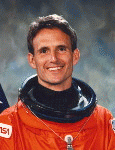
NAME: : J. M. Linenger, M.D., M.S.S.M., M.P.H., Ph.D. (Captain, Medical Corps, USN) NASA Astronaut
PERSONAL DATA: Born January 16, 1955, and raised in Eastpointe, Michigan. Married to the former Kathryn M. Bartmann of Arlington Heights, Illinois. They have two sons. He enjoys competitive triathalons, ocean swim racing, marathons, downhill and cross-country skiing, scuba diving, backpacking, camping. Siblings include Kenneth Linenger, Susan Barry, Karen Brandenburg, and Barbara Vallone, all residing in Michigan. His mother, Frances J. Linenger, resides in Eastpointe, Michigan. His father, Donald W. Linenger, is deceased.
EDUCATION: Graduated from East Detroit High School, Eastpointe, Michigan, in 1973; received a bachelor of science degree in bioscience from the U.S. Naval Academy in 1977; a doctorate in medicine from Wayne State University in 1981; a master of science degree in systems management from University of Southern California in 1988; a master of public health degree in health policy from the University of North Carolina in 1989; a doctor of philosophy degree in epidemiology from the University of North Carolina in 1989.
ORGANIZATIONS: The U.S. Naval Academy, University of Southern California, Wayne State University School of Medicine, and University of North Carolina Alumni Associations; the Association of Naval Aviation; the U. S. Navy Flight Surgeons Association; the Aerospace Medicine Association; the American Medical Association; the American College of Preventive Medicine; the Society of U.S. Navy Preventive Medicine Officers; and the American College of Sports Medicine. Linenger is board certified in preventive medicine.
SPECIAL HONORS: Awarded the Meritorious Unit Commendation; Navy Unit Commendation; National Defense Service Medal; Navy Battle Efficiency Award; Navy Commendation Medal with gold star; and 2 NASA Space Flight Medals. Top graduate, Naval Flight Surgeon Training and Naval Safety Officer's School. Elected to Phi Kappa Phi and Alpha Omega Alpha academic honor societies. Distinguished Alumni Award, Wayne State University School of Medicine. Gihon Award, Society of Naval Preventive Medicine Officers.
EXPERIENCE: Linenger graduated from the U.S. Naval Academy and proceeded directly to medical school. After completing surgical internship training at Balboa Naval Hospital, San Diego, California, and aerospace medicine training at the Naval Aerospace Medical Institute, Pensacola, Florida, he served as a naval flight surgeon at Cubi Point, Republic of the Philippines. He was then assigned as medical advisor to the Commander, Naval Air Forces, U.S. Pacific Fleet, San Diego. After completing doctorate-level training in epidemiology, Linenger returned to San Diego as a research principal investigator at the Naval Health Research Center. He concurrently served as a faculty member at the University of California-San Diego School of Medicine in the Division of Sports Medicine.
NASA EXPERIENCE: Linenger joined astronaut selection Group XIV at the Johnson Space Center in August 1992. He flew on STS-64 (September 9-20, 1994) aboard the Space Shuttle Discovery. Mission highlights included: first use of lasers for environmental research; deployment and retrieval of a solar science satellite; robotic processing of semiconductors; use of an RMS-attached boom for jet thruster research; first untethered spacewalk in 10 years to test a self-rescue jetpack. In completing his first mission, Linenger logged 10 days, 22 hours, 51 minutes in space, completed 177 orbits, and traveled over 4.5 million miles.
Following his first mission, he began training at the Cosmonaut Training Center in Star City, Russia, in preparation for a long-duration stay aboard the Russian Space Station Mir. All training was conducted using the Russian language, and consisted of learning all Mir Space Station systems (life support/electrical/communication/attitude control/computer systems), simulator training, Soyuz launch/return vehicle operations, and spacewalk water tank training. He also trained as chief scientist to conduct the entire US science program, consisting of over one-hundred planned experiments in various disciplines. A sampling includes: medicine (humoral immunity, sleep monitoring, radiation dosimetry), physiology (spatial orientation/performance changes during long duration flight), epidemiology (microbial surface sampling), metallurgy (determination of metal diffusion coefficients), oceanography/geology/limnology/physical science (photographic survey (over 10,000 photos) of the planet), space science (flame propagation), microgravity science (behavior of fluids, critical angle determination).
Linenger launched aboard U.S. Space Shuttle Atlantis (STS-81) on January 12, 1997, remained onboard the space station with two Russian cosmonauts upon undocking of the Shuttle, and eventually returned upon a different mission of Atlantis (STS-84) on May 24, 1997-spending a total of 132 days, 4 hours, 1 minute in space-the longest duration flight of an American male to date. During his stay aboard space station Mir, Linenger became the first American to conduct a spacewalk from a foreign space station and in a non-American made spacesuit.
During the five hour walk, he and his Russian colleague tested for the first time ever the newly designed Orlan-M Russian-built spacesuit, installed the Optical Properties Monitor (OPM) and Benton dosimeter on the outer surface of the station, and retrieved for analysis on Earth numerous externally-mounted material-exposure panels. The three crewmembers also performed a "flyaround" in the Soyuz spacecraft-undocking from one docking port of the station, manually flying to and redocking the capsule at a different location-thus making Linenger the first American to undock from a space station aboard two different spacecraft (U.S. Space Shuttle and Russian Soyuz).
While living aboard the space station , Linenger and his two Russian crewmembers faced numerous difficulties-the most severe fire ever aboard an orbiting spacecraft, failures of onboard systems (oxygen generator, carbon dioxide scrubbing, cooling line loop leaks, communication antenna tracking ability, urine collection and processing facility), a near collision with a resupply cargo ship during a manual docking system test, loss of station electrical power, and loss of attitude control resulting in a slow, uncontrolled "tumble" through space. In spite of these challenges and added demands on their time (in order to carry out the repair work), they still accomplished all mission goals-spacewalk, flyaround, and one-hundred percent of the planned U.S. science experiments.
In completing the nearly five month mission, Linenger logged approximately 50 million miles (the equivalent of over 110 roundtrips to the Moon and back), more than 2000 orbits around the Earth, and traveled at an average speed of 18,000 miles per hour. Because of the flawless launch, docking, undocking, and landing of the Space Shuttle Atlantis (STS-84) crew-exchange mission, he made it back to the planet just in time to be reunited with Kathryn and to witness the birth of their second son.